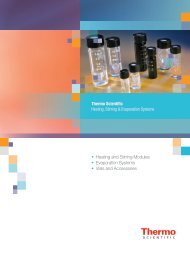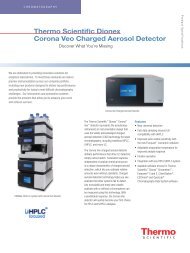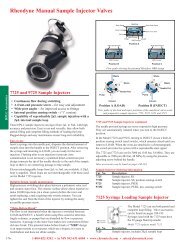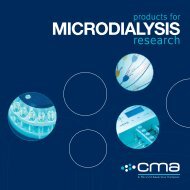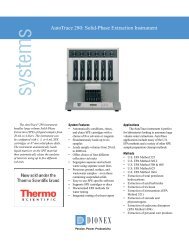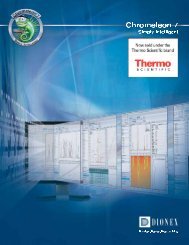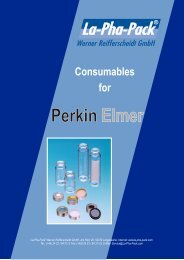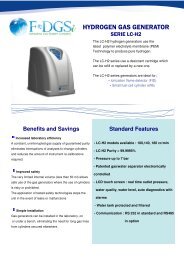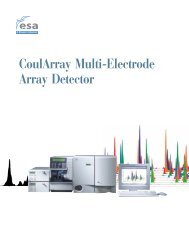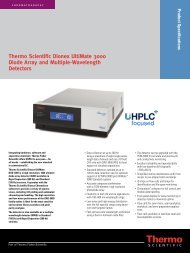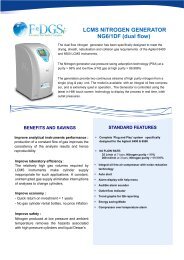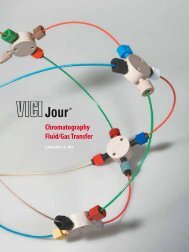Shodex Catalogue 2013-2015.pdf - Analytics Shop
Shodex Catalogue 2013-2015.pdf - Analytics Shop
Shodex Catalogue 2013-2015.pdf - Analytics Shop
You also want an ePaper? Increase the reach of your titles
YUMPU automatically turns print PDFs into web optimized ePapers that Google loves.
InformationColumn Cleaning ProceduresChanges in peak shape, elution time, or elevated column pressure may be resolved by cleaning the column. Thissection describes general indications of column deterioration and column cleaning procedures.For details of column cleaning procedures, refer to each column’s specific operation manual.Typical indicators of column deterioration possibilityColumn Cleaning Procedures1. Elevated column pressure2. Abnormal peak shapes (broadening, leading, or tailing) and split peaks3. Change in retention time4. Unstable baselineSelection guide to the cleaning solventSolvents capable of dissolving the adsorbed substancesSolvents with high eluting power (variable depending on separation mode)*Use the solvent specified in the operation manual.Standard cleaning proceduresFor an efficient cleaning, reverse the direction and reduce the flow rate to 1/3 of the regular flow.Columns forreversed phasechromatographyColumns forsugar analysischromatographyColumns foraqueous SEC (GFC)chromatographyColumns forion exchangechromatographyClean the columns with solvent containing higher concentration of organic solvent such asmethanol, acetonitrile, or THF.(In case of using buffer as a mobile phase, miscibility of the buffer solution and the organicsolvents need to be checked)[Ligand exchange columns (SUGAR series)]• In case of counter ion detachmentFlush or inject solvent containing the salt corresponding to the modified counter-ligand.[Polymer-base amino columns (NH2P series)]• In cases where an acidic substance has been bound to the amino functional groupFlush with solvents in the following sequence: water, 0.1M perchloric acid (aq.), water,0.1M NaOH (aq.), water, and mobile phase.• In cases where an ionic substance has been adsorbedUse a solvent with higher salt concentration or solvent with different pH from the mobile phase.• In cases where a hydrophobic substance has been adsorbedUse a solvent containing organic solvent.(In case of using buffer as a mobile phase, miscibility of the buffer solution and the organicsolvents need to be checked)• In cases where an ionic substance has been adsorbedUse a solvent with higher salt concentration or solvent with different pH from the mobile phase.• In cases where a hydrophobic substance has been adsorbedUse a solvent containing organic solvent.(In case of using buffer as a mobile phase, miscibility of the buffer solution and the organicsolvents need to be checked)• In cases where protein have been adsorbedInject 1-2 mL of 0.1 M NaOH (aq.) or 30% (v/v) acetic acid (aq.) several times.Columns forhydrophobic interactionchromatography• In cases where protein have been adsorbedInject 1-2 mL of 0.1 M NaOH (aq.) or 30% (v/v) acetic acid (aq.) several times.*The required volume of the cleaning solvent is 5-10 times the column volume.*Avoid pressure elevation during the cleaning.*The cleaning is limited and does not guarantee the full regeneration of the column to its original condition.For your informationOne typical cause of the column pressure elevation is the clogging of solid substances at the inlet filter of the column.In this case, reverse the direction and reduce the flow to 1/3 of the regular flow rate. This may remove the solidsubstance causing the elevated pressure.86*Use the solvent specified in the operation manual.



